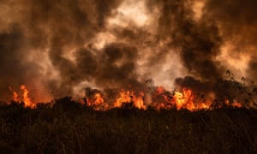
“Breaking News: Unprecedented Fire Endangers Brazil’s Ecological Treasure in CORUMBA”
By Fiona Nanna, ForeMedia News
3 minutes read. Updated 5:30AM GMT Wed, June 12, 2024
Amidst the tranquil expanse of Brazil’s Pantanal wetlands, a crisis of epic proportions unfolds as wildfires surge, casting a pall over the region’s rich biodiversity. Jose Cleiton and Brandao Amilton, traversing the Pantanal on horseback, bear witness to an ominous sight: towering smoke columns piercing the horizon.
According to the Brazilian National Institute of Space Research (INPE), Pantanal fires have surged tenfold compared to the same period last year, exacerbating concerns for local residents like Amilton, a fishing guide, who describes the suffocating smoke and intensifying heat as threats to both livelihoods and lives. With the dry season yet to peak, fears mount for the Pantanal’s vulnerable ecosystem.
Spanning an area ten times larger than Florida’s Everglades, the Pantanal is home to a diverse array of wildlife, including jaguars and giant anteaters. However, weakened by scant rains since late last year, the wetlands stand defenseless against the encroaching flames. The specter of the catastrophic 2020 fires, which ravaged a third of the Pantanal, looms large as experts brace for a potentially graver crisis.
According to the Federal University of Rio de Janeiro’s satellite monitoring program, a record-breaking 3,400 square kilometers (1,315 square miles) of the Pantanal have succumbed to flames from January 1 to June 9, highlighting the urgency of the situation. Meanwhile, the stark contrast with record flooding in Rio Grande do Sul underscores the interconnectedness of environmental upheavals exacerbated by climate change.
As Brazil’s Pantanal confronts this unprecedented wildfire surge, global attention converges on the urgent need for coordinated action to mitigate the impacts of climate change and safeguard precious ecosystems. With hashtags like #PantanalCrisis and #ClimateEmergency gaining traction, the world watches with bated breath, hoping for a reprieve amidst the flames of adversity.

